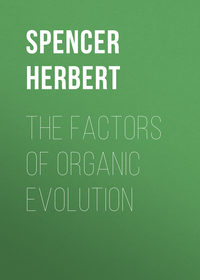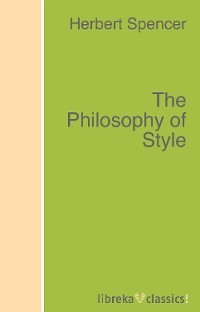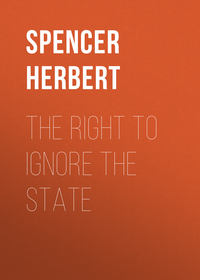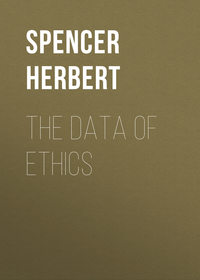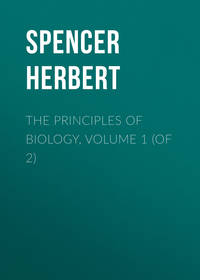 полная версия
полная версияEssays: Scientific, Political, and Speculative, Volume II
As this observation suggests, it will be well, before tracing the mode in which exact science emerges from the inexact judgments of the senses, and showing the non-serial evolution of its divisions, to note the non-serial character of those preliminary processes of which all after development is a continuation. On re-considering them it will be seen that not only are they divergent branches from a common root, – not only are they simultaneous in their growth; but that they are mutual aids; and that none can advance without the rest. That progress of classification for which the unfolding of the perceptions paves the way, is impossible without a corresponding progress in language, by which greater varieties of objects are thinkable and expressible. On the one hand classification cannot be carried far without names by which to designate the classes; and on the other hand language cannot be made faster than things are classified. Again, the multiplication of classes and the consequent narrowing of each class, itself involves a greater likeness among the things classed together; and the consequent approach towards the notion of complete likeness itself allows classification to be carried higher. Moreover, classification necessarily advances pari passu with rationality – the classification of things with the classification of relations. For things that belong to the same class are, by implication, things of which the properties and modes of behaviour – the co-existences and sequences – are more or less the same; and the recognition of this sameness of co-existences and sequences is reasoning. Whence it follows that the advance of classification is necessarily proportionate to the advance of generalizations. Yet further, the notion of likeness , both in things and relations, simultaneously evolves by one process of culture the ideas of equality of things and equality of relations; which are the respective bases of exact concrete reasoning and exact abstract reasoning – Mathematics and Logic. And once more, this idea of equality, in the very process of being formed, necessarily gives origin to two series of relations – those of magnitude and those of number; from which arise geometry and the calculus. Thus the process throughout is one of perpetual subdivision and perpetual intercommunication of the divisions. From the very first there has been that consensus of different kinds of knowledge, answering to the consensus of the intellectual faculties, which, as already said, must exist among the sciences.
Let us now go on to observe how, out of the notions of equality and number , as arrived at in the manner described, there gradually arose the elements of quantitative prevision.
Equality, once having come to be definitely conceived, was recognizable among other phenomena than those of magnitude. Being predicable of all things producing indistinguishable impressions, there naturally grew up ideas of equality in weights, sounds, colours, &c.; and, indeed, it can scarcely be doubted that the occasional experience of equal weights, sounds, and colours, had a share in developing the abstract conception of equality – that the ideas of equality in sizes, relations, forces, resistances, and sensible properties in general, were evolved during the same stage of mental development. But however this may be, it is clear that as fast as the notion of equality gained definiteness, so fast did that lowest kind of quantitative prevision which is achieved without any instrumental aid, become possible. The ability to estimate, however roughly, the amount of a foreseen result, implies the conception that it will be equal to a certain imagined quantity; and the correctness of the estimate will manifestly depend on the precision which the perceptions of sensible equality have reached. A savage with a piece of stone in his hand, and another piece lying before him of greater bulk but of the same kind (sameness of kind being inferred from the equality of the two in colour and texture) knows about what effort he must put forth to raise this other piece; and he judges accurately in proportion to the accuracy with which he perceives that the one is twice, three times, four times, &c. as large as the other; that is – in proportion to the precision of his ideas of equality and number. And here let us not omit to notice that even in these vaguest of quantitative previsions, the conception of equality of relations is also involved. For it is only in virtue of an undefined consciousness that the relation between bulk and weight in the one stone is equal to the relation between bulk and weight in the other, that even the roughest approximation can be made.
But how came the transition from those uncertain perceptions of equality which the unaided senses give, to the certain ones with which science deals? It came by placing the things compared in juxtaposition. Equality being asserted of things which give us indistinguishable impressions, and no distinct comparison of impressions being possible unless they occur in immediate succession, it results that exactness of equality is ascertainable in proportion to the closeness of the compared things. Hence the fact that when we wish to judge of two shades of colour whether they are alike or not, we place them side by side; hence the fact that we cannot, with any precision, say which of two allied sounds is the louder, or the higher in pitch, unless we hear the one immediately after the other; hence the fact that to estimate the ratio of weights, we take one in each hand, that we may compare their pressures by rapidly alternating in thought from the one to the other; hence the fact, that in a piece of music, we can continue to make equal beats when the first beat has been given, but cannot ensure commencing with the same length of beat on a future occasion; and hence, lastly, the fact, that of all magnitudes, those of linear extension are those of which the equality is most precisely ascertainable, and those to which, by consequence, all others have to be reduced. For it is the peculiarity of linear extension that it alone allows its magnitudes to be placed in absolute juxtaposition, or, rather, in coincident position; it alone can test the equality of two magnitudes by observing whether they will coalesce, as two equal mathematical lines do, when placed between the same points; it alone can test equality by trying whether it will become identity. Hence, then, the fact, that all exact science is reducible, by an ultimate analysis, to results measured in equal units of linear extension.
Still it remains to be noticed in what manner this determination of equality by comparison of linear magnitudes originated. Once more may we perceive that surrounding natural objects supplied the needful lessons. From the beginning there must have been a constant experience of like things placed side by side – men standing and walking together; animals from the same herd; fish from the same shoal. And the ceaseless repetition of these experiences could not fail to suggest the observation, that the nearer together any objects were, the more visible became any inequality between them. Hence the obvious device of putting in apposition, things of which it was desired to ascertain the relative magnitudes. Hence the idea of measure. And here we suddenly come upon a group of facts which afford a solid basis to the remainder of our argument; while they also furnish strong evidence in support of the foregoing speculations. Those who look sceptically on this attempted rehabilitation of early mental development, and who think that the derivation of so many primary notions from organic forms is somewhat strained, will perhaps see more probability in the hypotheses which have been ventured, on discovering that all measures of extension and force originated from the lengths and weights of organic bodies, and all measures of time from the periodic phenomena of either organic or inorganic bodies.
Thus, among linear measures, the cubit of the Hebrews was the length of the forearm from the elbow to the end of the middle finger; and the smaller scriptural dimensions are expressed in hand-breadths and spans. The Egyptian cubit, which was similarly derived, was divided into digits, which were finger-breadths; and each finger-breadth was more definitely expressed as being equal to four grains of barley placed breadthwise. Other ancient measures were the orgyia or stretch of the arms , the pace , and the palm. So persistent has been the use of these natural units of length in the East, that even now some Arabs mete out cloth by the forearm. So, too, is it with European measures. The foot prevails as a dimension throughout Europe, and has done so since the time of the Romans, by whom, also, it was used: its lengths in different places varying not much more than men’s feet vary. The heights of horses are still expressed in hands. The inch is the length of the terminal joint of the thumb; as is clearly shown in France, where pouce means both thumb and inch. Then we have the inch divided into three barley-corns. So completely, indeed, have these organic dimensions served as the substrata of mensuration, that it is only by means of them that we can form any estimate of some of the ancient distances. For example, the length of a degree on the Earth’s surface, as determined by the Arabian astronomers shortly after the death of Haroun-al-Raschid, was fifty-six of their miles. We know nothing of their mile further than that it was 4000 cubits; and whether these were sacred cubits or common cubits, would remain doubtful, but that the length of the cubit is given as twenty-seven inches, and each inch defined as the thickness of six barley-grains. Thus one of the earliest measurements of a degree comes down to us in barley-grains. Not only did organic lengths furnish those approximate measures which satisfied men’s needs in ruder ages, but they furnished also the standard measures required in later times. One instance occurs in our own history. To remedy the irregularities then prevailing, Henry I. commanded that the ulna, or ancient ell, which answers to the modern yard, should be made of the exact length of his own arm.
Measures of weight had a kindred derivation. Seeds seem commonly to have supplied the units. The original of the carat used for weighing in India is a small bean. Our own systems, both troy and avoirdupois, are derived primarily from wheat-corns. Our smallest weight, the grain is a grain of wheat. This is not a speculation; it is an historically-registered fact. Henry III. enacted that an ounce should be the weight of 640 dry grains of wheat from the middle of the ear. And as all the other weights are multiples or sub-multiples of this, it follows that the grain of wheat is the basis of our scale. So natural is it to use organic bodies as weights, before artificial weights have been established, or where they are not to be had, that in some of the remoter parts of Ireland the people are said to be in the habit, even now, of putting a man into the scales to serve as a measure for heavy commodities.
Similarly with time. Astronomical periodicity, and the periodicity of animal and vegetable life, are simultaneously used in the first stages of progress for estimating epochs. The simplest unit of time, the day, nature supplies ready made. The next simplest period, the moneth or month, is also thrust upon men’s notice by the conspicuous changes constituting a lunation. For larger divisions than these, the phenomena of the seasons, and the chief events from time to time occurring, have been used by early and uncivilized races. Among the Egyptians the rising of the Nile served as a mark. The New Zealanders were found to begin their year from the reappearance of the Pleiades above the sea. One of the uses ascribed to birds, by the Greeks, was to indicate the seasons by their migrations. Barrow describes the aboriginal Hottentot as expressing dates by the number of moons before or after the ripening of one of his chief articles of food. He further states that the Kaffir chronology is kept by the moon, and is registered by notches on sticks – the death of a favourite chief, or the gaining of a victory, serving for a new era. By which last fact, we are at once reminded that in early history, events are commonly recorded as occurring in certain reigns, and in certain years of certain reigns: a proceeding which made a king’s reign a rude measure of duration. And, as further illustrating the tendency to divide time by natural phenomena and natural events, it may be noticed that even by our own peasantry the definite divisions of months and years are but little used; and that they habitually refer to occurrences as “before sheep-shearing,” or “after harvest,” or “about the time when the squire died.” It is manifest, therefore, that the approximately equal periods perceived in Nature gave the first units of measure for time; as did Nature’s approximately equal lengths and weights give the first units of measure for space and force.
It remains only to observe, that measures of value were similarly derived. Barter, in one form or other, is found among all but the very lowest human races. It is obviously based upon the notion of equality of worth. And as it gradually merges into trade by the introduction of some kind of currency, we find that the measures of worth , constituting this currency, are organic bodies; in some cases cowries , in others cocoa-nuts , in others cattle , in others pigs; among the American Indians peltry or skins , and in Iceland dried fish.
Notions of exact equality and of measure having been reached, there arose definite ideas of magnitudes as being multiples one of another; whence the practice of measurement by direct apposition of a measure. The determination of linear extensions by this process can scarcely be called science, though it is a step towards it; but the determination of lengths of time by an analogous process may be considered as one of the earliest samples of quantitative prevision. For when it is first ascertained that the moon completes the cycle of her changes in about thirty days – a fact known to most uncivilized tribes that can count beyond the number of their fingers – it is manifest that it becomes possible to say in what number of days any specified phase of the moon will recur; and it is also manifest that this prevision is effected by an apposition of two times, after the same manner that linear space is measured by the apposition of two lines. For to express the moon’s period in days, is to say how many of these units of measure are contained in the period to be measured – is to ascertain the distance between two points in time by means of a scale of days , just as we ascertain the distance between two points in space by a scale of feet or inches; and in each case the scale coincides with the thing measured – mentally in the one, visibly in the other. So that in this simplest, and perhaps earliest case of quantitative prevision, the phenomena are not only thrust daily upon men’s notice, but Nature is, as it were, perpetually repeating that process of measurement by observing which the prevision is effected.
This fact, that in very early stages of social progress it is known that the moon goes through her changes in nearly thirty days, and that in rather more than twelve moons the seasons return – this fact that chronological astronomy assumes a certain scientific character even before geometry does; while it is partly due to the circumstance that the astronomical divisions, day, month, and year, are ready made for us, is partly due to the further circumstances that agricultural and other operations were at first regulated astronomically, and that from the supposed divine nature of the heavenly bodies their motions determined the periodical religious festivals. As instances of the one we have the observation of the Egyptians, that the rising of the Nile corresponded with the heliacal rising of Sirius; the directions given by Hesiod for reaping and ploughing, according to the positions of the Pleiades; and his maxim that “fifty days after the turning of the sun is a seasonable time for beginning a voyage.” As instances of the other, we have the naming of the days after the sun, moon, and planets; the early attempts among Eastern nations to regulate the calendar so that the gods might not be offended by the displacement of their sacrifices; and the fixing of the great annual festival of the Peruvians by the position of the sun. In all which facts we see that, at first, science was simply an appliance of religion and industry.
After the discoveries that a lunation occupies nearly thirty days, and that some twelve lunations occupy a year – discoveries which we may infer were the earliest, from the fact that existing uncivilized races have made them – we come to the first known astronomical records, which are those of eclipses. The Chaldeans were able to predict these. “This they did, probably,” says Dr. Whewell in his useful history, from which most of the materials we are about to use will be drawn, “by means of their cycle of 223 months, or about eighteen years; for, at the end of this time, the eclipses of the moon begin to return, at the same intervals and in the same order as at the beginning.” Now this method of calculating eclipses by means of a recurring cycle, – the Saros as they called it – is a more complex case of prevision by means of coincidence of measures. For by what observations must the Chaldeans have discovered this cycle? Obviously, as Delambre infers, by inspecting their registers; by comparing the successive intervals; by finding that some of the intervals were alike; by seeing that these equal intervals were eighteen years apart; by discovering that all the intervals that were eighteen years apart were equal; by ascertaining that the intervals formed a series which repeated itself, so that if one of the cycles of intervals were superposed on another the divisions would fit. And this being once perceived, it became possible to use the cycle as a scale of time by which to measure out future periods of recurrence. Seeing thus that the process of so predicting eclipses, is in essence the same as that of predicting the moon’s monthly changes by observing the number of days after which they repeat – seeing that the two differ only in the extent and irregularity of the intervals; it is not difficult to understand how such an amount of knowledge should so early have been reached. And we shall be the less surprised on remembering that the only things involved in these previsions were time and number; and that the time was in a manner self-numbered.
Still, the ability to predict events recurring only after so long a period as eighteen years, implies a considerable advance in civilization – a considerable development of general knowledge; and we have now to inquire what progress in other sciences accompanied, and was necessary to, these astronomical previsions. In the first place, there must have been a tolerably efficient system of calculation. Mere finger-counting, mere head-reckoning, even with the aid of a decimal notation, could not have sufficed for numbering the days in a year; much less the years, months, and days between eclipses. Consequently there must have been a mode of registering numbers; probably even a system of numerals. The earliest numerical records, if we may judge by the practices of the less civilized races now existing, were probably kept by notches cut on sticks, or strokes marked on walls; much as public-house scores are kept now. And there is reason to think that the first numerals used were simply groups of straight strokes, as some of the still-extant Roman ones are; leading us to suspect that these groups of strokes were used to represent groups of fingers, as the groups of fingers had been used to represent groups of objects – a supposition harmonizing with the aboriginal practice of picture writing. Be this so or not, however, it is manifest that before the Chaldeans discovered their Saros , they must have had both a set of written symbols serving for an extensive numeration, and a familiarity with the simpler rules of arithmetic.
Not only must abstract mathematics have made some progress, but concrete mathematics also. It is scarcely possible that the buildings belonging to this era should have been laid out and erected without any knowledge of geometry. At any rate, there must have existed that elementary geometry which deals with direct measurement – with the apposition of lines; and it seems that only after the discovery of those simple proceedings, by which right angles are drawn, and relative positions fixed, could so regular an architecture be executed. In the case of the other division of concrete mathematics – mechanics, we have definite evidence of progress. We know that the lever and the inclined plane were employed during this period: implying that there was a qualitative prevision of their effects, if not a quantitative one. But we know more. We read of weights in the earliest records; and we find weights in ruins of the highest antiquity. Weights imply scales, of which we have also mention; and scales involve the primary theorem of mechanics in its least complicated form – involve not a qualitative but a quantitative prevision of mechanical effects. And here we may notice how mechanics, in common with the other exact sciences, took its rise from the simplest application of the idea of equality. For the mechanical proposition which the scales involve, is, that if a lever with equal arms, have equal weights suspended from them, the weights will remain at equal altitudes. And we may further notice how, in this first step of rational mechanics, we see illustrated the truth awhile since named, that as magnitudes of linear extension are the only ones of which the equality is exactly ascertainable, the equalities of other magnitudes have at the outset to be determined by means of them. For the equality of the weights which balance each other in scales, depends on the equality of the arms: we can know that the weights are equal only by proving that the arms are equal. And when by this means we have obtained a system of weights, – a set of equal units of force and definite multiples of them, then does a science of mechanics become possible. Whence, indeed, it follows, that rational mechanics could not possibly have any other starting-point than the scales.
Let us further remember that during this same period there was some knowledge of chemistry. Sundry of the arts which we know to have been carried on, were made possible only by a generalized experience of the modes in which certain bodies affect each other under special conditions. In metallurgy, which was extensively practised, this is abundantly illustrated. And we even have evidence that in some cases the knowledge possessed was, in a sense, quantitative. For, as we find by analysis that the hard alloy of which the Egyptians made their cutting tools, was composed of copper and tin in fixed proportions, there must have been an established prevision that such an alloy was to be obtained only by mixing them in these proportions. It is true, this was but a simple empirical generalization; but so was the generalization respecting the recurrence of eclipses; so are the first generalizations of every science.
Respecting the simultaneous advance of the sciences during this early epoch, it remains to point out that even the most complex of them must have made some progress. For under what conditions only were the foregoing developments possible? The conditions furnished by an established and organized social system. A long continued registry of eclipses; the building of palaces; the use of scales; the practice of metallurgy – alike imply a settled and populous nation. The existence of such a nation not only presupposes laws and some administration of justice, which we know existed, but it presupposes successful laws – laws conforming in some degree to the conditions of social stability – laws enacted because it was found that the actions forbidden by them were dangerous to the State. We do not by any means say that all, or even the greater part, of the laws were of this nature; but we do say, that the fundamental ones were. It cannot be denied that the laws affecting life and property were such. It cannot be denied that, however little these were enforced between class and class, they were to a considerable extent enforced between members of the same class. It can scarcely be questioned, that the administration of them between members of the same class was seen by rulers to be necessary for keeping society together. But supposition aside, it is clear that the habitual recognition of these claims in their laws, implied some prevision of social phenomena. That same idea of equality , which, as we have seen, underlies other science, underlies also morals and sociology. The conception of justice, which is the primary one in morals; and the administration of justice, which is the vital condition to social existence; are impossible without the recognition of a certain likeness in men’s claims, in virtue of their common humanity. Equity literally means equalness; and if it be admitted that there were even the vaguest ideas of equity in these primitive eras, it must be admitted that there was some appreciation of the equalness of men’s liberties to pursue the objects of life – some appreciation, therefore, of the essential principle of national equilibrium.



